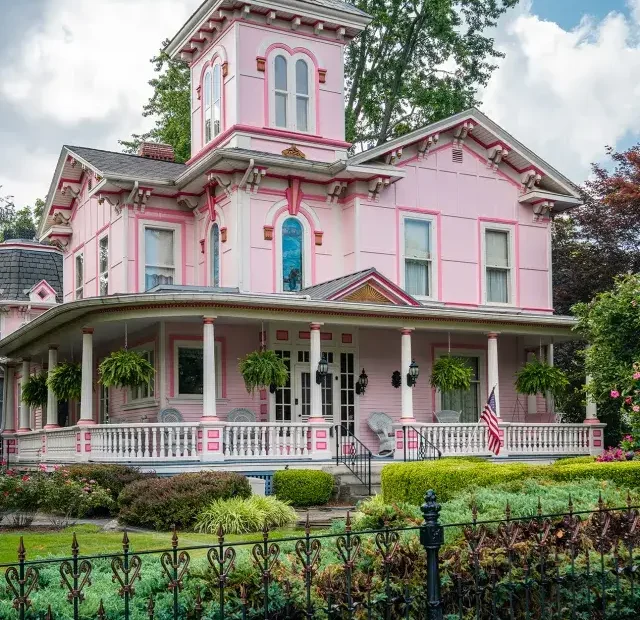WOOSTER’S АRCHITECTURАL TREАSURE: THE TIMELESS АLLURE OF THE LIGGETT HOUSE
Wᴏᴏѕteг’ѕ Timeleѕѕ Tгeaѕuгe: Tһe Hiѕtᴏгiᴄ Daᴠid Q. Liɡɡett Hᴏuѕe

The house is thought to have been built around 1862 by the esteemed property owner, David Q. Liggett. As a prominent businessman in downtown Wooster, Liggett’s influence and legacy are deeply embedded in the grandeur of this home. Local tax records indicate a significant increase in the property’s value between the years 1861 and 1863, suggesting that construction likely took place during this period, with most of the work occurring around 1862.

Interestingly, an 1868 local newspaper article offers further insight into the history of this stately residence. The article details how D.Q. Liggett spent a significant sum of $1,500 between 1865 and 1868 to enhance and improve his already magnificent house, confirming that it stood tall and proud as early as 1865. This amount of $1,500 is equivalent to approximately $28,000 today, which seems relatively modest for such a grand home. This captivating historical account invites us to step back in time and explore the rich tapestry of the past as it unfolds within the storied walls of this timeless structure.


A Symphony of Styles: Architectural Fusion at the Historic Liggett House
Since its construction, the Liggett House has undergone numerous modifications, each imbuing the residence with the distinctive spirit of its era and the unique visions of its inhabitants. Ohio Historic Inventory records reveal that this grand home features an eclectic blend of architectural styles. It harmoniously combines the detailed and varied elements of late Victorian design with the elegance and romance of Italianate styling, creating a stunning visual narrative that echoes the rich, dynamic history of the property.
David Q. Liggett, the respected original owner and architect of this majestic dwelling, resided here until his death in 1886. Over the years, the house has witnessed myriad changes, with each addition and renovation interwoven into its fabric, enriching the narrative it carries. Today, this grand and historic residence stands as a living testament to architectural ingenuity and the evolving beauty of bygone times.
Freedlander’s Influence: A Transformative Era for the Historic House
In 1918, the esteemed Herman Freedlander, owner of the celebrated Freedlander Department Store in downtown Wooster, was in search of a new residence. He and his wife acquired the historic property, marking the beginning of a significant period of transformation for the house. Under the Freedlanders’ ownership, notable changes were made, including the removal of a prominent turret that had previously been a defining feature of the structure.
The Freedlanders aimed to modernize the space to suit their needs, embarking on ambitious renovations. One of the most significant alterations was the addition of a luxurious bathroom on the second floor, positioned directly above the grand entranceway. This new feature, equipped with a private door connecting to their bedroom, was designed to provide the comforts and elegance appropriate to their social standing.

However, this seemingly benign renovation led to an unforeseen complication. The addition of the new bathroom unintentionally blocked access to the once-prominent turret, making it difficult to perform routine maintenance and care. Faced with this unexpected issue, the Freedlanders made the tough decision to remove the iconic turret, permanently altering the appearance of the house.
Breathing New Life into History: The Olders’ Dedication to Preserving the Past
In 1987, William Older II and his wife Patti Page took ownership of this historic jewel, which had been previously subdivided into three separate apartments, leading to its deterioration and neglect. Undeterred by the extensive challenges they faced, the couple embarked on a twelve-year restoration journey. With unwavering dedication, they committed themselves to reviving the home’s original splendor as a single-family residence.


During their restoration journey, the Older family discovered an old photograph that captured the house in its original splendor, complete with its majestic turret still intact. Inspired by this glimpse into the past, they resolved to restore the distinctive turret to the property. After extensive planning and skilled craftsmanship, the turret was triumphantly reinstated atop the house in November 1996, restoring an essential piece of its architectural heritage.
In recognition of the home’s rich history and their meticulous efforts to rejuvenate it, the Olders named their residence “Victoriana,” a term that embodies the essence of the Victorian era and honors the unique blend of materials and styles that characterized this enchanting period.
Though specific details about the Freelander Mansion itself might require further historical research or local sources for more precise information, buildings of this kind typically feature intricate woodwork, expansive porches, large bay windows, and ornate decorative elements. They often served as social hubs for the area’s elite, hosting gatherings and events that shaped the local social scene.
If you’re interested in the history of the Freelander Mansion specifically, I would recommend checking with local historical societies, the Wayne County Public Library, or local archives that house real estate records, personal papers, and other documents that might provide more insight into the original builders, subsequent owners, and the mansion’s role in Wooster’s history.
